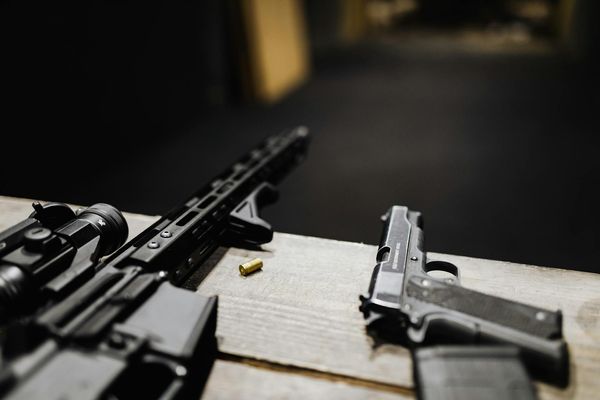
A boot room is one of the most practical additions you could make to your home. A spot to store muddy boots and wet coats as well as to hose down mucky pups, it's a room that you won't know you're missing until you suddenly can't live without it.
Similar to a utility room, it often has many of the same design features but with a slightly different focus. It's less about the laundry and more about containing any mess and mud to the back of the house, which is particularly crucial for those who live in and amongst the great outdoors.
If you're wondering whether it's time to create a long sought-after boot room, or perhaps yours is due a style upgrade after years of wear and tear, these tips from the pros will be the perfect place to start.
Boot room ideas
Even the smallest of spaces can be transformed to provide you with a space for taking off shoes and coats before entering the main area of the house.
A beautifully well-organised boot room is not just about clearing clutter; it's also about creating a practical space to make life easier for the whole family. We've got storage and layout ideas to inspire, but before you start planning, make sure you've invested in hard-wearing paint and robust flooring to cope with high foot traffic on a daily basis – in all weathers! Because while this room is highly practical, it shouldn't be a space that is neglected when it comes to style and to avoid making any utility room design mistakes, it's best to be prepared.
Be inspired and get organised with these stylish boot room ideas for sorting your home.
1. Go for a bold colour scheme

Sure, a boot room is a practical space, but this doesn't mean you have to play it safe when it comes to colour scheme. While pastel shades are timeless and indicative of countryside decor, turning a boot room into a design feature will add a burst of joy into daily chores (cleaning football boots, we're looking at you).
Take inspiration from utility room colour ideas to find an on-trend shade that works with the rest of your home. We love this muted tomato shade that is the perfect amount of playful.
2. Add in open shelving

Built-in storage reigns supreme when it comes to a practical boot room, however, open shelving will create just the right amount of personality.
Swapping some wall cupboards for open shelving will help to make the room feel bigger and brighter and also provide a space to show off your favourite knick-knacks. Position above a sink and decorate with soap and brushes for dual-purpose decor.
3. Create a bootility

Why not combine the two rooms that work the hardest? A bootility is a cross between a boot room and utility room and functions as a place to house outdoor gear and a spot to wash it.
'It gives you a defined point where outdoor kit, laundry and everyday clutter can be managed before it spreads into the rest of the house,' explains Richard Davonport, managing director of Davonport.
So what must it contain? 'From a cabinetry perspective, a mixture of open and closed storage is often what the final design has; tall cupboards for appliances and cleaning products, open shelves or peg rails for quick-grab items, and a bench with space underneath for shoes,' Richard adds.
4. Utilise every last inch

Typically a boot room is an additional space adjoining your kitchen or utility room so it may not be the most spacious. But that doesn't mean you can't squeeze in the storage and make the most of every nook and cranny, even if you're looking for small utility room ideas.
Ben says, 'Every inch of space in your boot room should be considered to maximise storage and purpose. From the dog lead and ironing board to muddy walking boots and coats, a made-to-measure boot room is an ideal place to keep your daily essentials. Not only can your boot room provide essential storage, but it can also offer a seating area for putting coats and shoes on with ease.'
It's also worth remembering that adding soft furnishings like curtains, blinds and cushions will help to create a more comfortable space, that while practical, can still look beautiful.
5. Keep it cosy

Heating your boot room might not be at the top of your to-do list, but it's not one to be neglected. Simon Morris, Marketing Manager at The Radiator Company advises, 'Boot rooms almost always need a radiator, however small. By their nature, they often contain wet items of clothing so you need to be able to regulate the temperature to avoid the entire room feeling cold and damp. As space is often limited, the planning of where to put everything must be done carefully to enable the room to be totally useful. Choosing a multi-functional radiator, like our Ancona Bench Seat, combines practicality with great design, adding a touch of vintage styling but with modern day convenience.'
6. Look to cubbies

Cubbies are ideal for organising all the random bits and bobs that can often end up in a Boot room. Not only are they ideal for boots and shoes, they can house baskets and canisters too, keeping a curb on the clutter.
Claire Wilkes, Senior Buyer at Garden Trading says, 'There is very little that we find as satisfying as rooms across the home that are beautifully organised and tidy, and storage is just as important in the boot room as the bedroom.'
'The key is plenty of it, and don’t forget to use your wall space as well as including cabinets and drawers. Consider a row of pegs to hang up a whole family of wet coats. A stylish and perfectly practical option is storage that incorporates cubbies of different sizes – somewhere to house your kids’ trainers, wellies of all sizes, hats, gloves and a spot in the corner for your brolly.'
7. Mirror your kitchen design

Boot rooms are most often positioned next to a kitchen so it makes sense to replicate the same colours and designs. Even if your boot room isn't adjoining, you might find it's cheaper to use the same worktops and cabinets as your kitchen and have them installed at the same time too.
Tori Summers, Director of Design, Product & Innovation at Howdens says, 'An approach many homeowners take to designing their boot room is to mirror the design of their kitchen. Choosing the same flooring, cabinetry and work surfaces can make both rooms feel like a natural extension of the existing space.'
'However, if you are wanting to have some fun, these rooms make great spaces in which to experiment with colour. Perhaps you have a favourite colour or shade or feel like trying something bold but don’t want to do it in your main kitchen area, then these are the rooms to try it in.'
8. Factor in a pooch parlour

It might seem like a fairly boujee thing to include in your boot room, but a dog shower can actually make a lot of sense (if you have a dog that is!). If you're fed up with your pooch traipsing mud through the house after their walk, or are done with having to wrestle them upstairs to the bath, then a dog shower could be the answer.
Tori explains. 'A large and deep sink is essential in a boot room as it will have a multitude of uses, from handwashing clothes to cleaning muddy paws and rinsing boots. But at the height of luxury is a separate dog washing sink/shower that is much lower than countertops so that your pooch can easily get in and out. As a nation of pet lovers, it is a trend that we’re seeing grow at a significant rate!'
9. Transform a cosy corner

If you've no space for an entire room for coats and boots, how about turning a corner of your hallway or utility room into a space for these items? A peg rail hung on the wall will provide ample space for coats and jackets, while boots can be neatly lined up besides free-standing storage. If you have dogs that regularly need walking, create a little 'station' with all the things you'll need such as leads, treats, and balls, all stored in easy-to-access baskets.
10. Utilise an alcove space

An alcove space in a kitchen, hallway or utility room, can quickly be turned into the perfect place to store boots and coats, by building a floor to ceiling cupboard. While open shelves are often the most popular choice for alcoves, a cupboard with doors means you can hide away muddy boots and old coats from sight. Fix a rail inside your cupboards to hang coats on hangers and keep boots on a rack so they can be stored upside down. This will prevent muddy puddles forming at the bottom of your cupboard.
If space allows, why not dedicate one cupboard for winter wear and one for summer, so that the right coats and boots are always on hand as you dash out the door.
11. Make a feature of your storage

Contrary to the last idea, how about making a feature of your storage, rather than hiding it away? Here the homeowner has opted for floor to ceiling open shelving which once filled with their boots, shoes and wicker storage baskets, makes a striking and eye-catching display. Paint your shelving the same colour as the wall behind so that its the items on each shelf that do the talking and the storage blends seamlessly into the room.
12. Move your boot room outside

No space inside for your boots and coats? What about a space outside on a veranda or porch? Any sheltered space can work as a place to hang up coats and keep boots, so here a peg rail and some all-weather storage baskets will be your friends. Fixing a light onto the wall is a clever idea too, so when you return from dark, winter walks, or even late-night summer ones, you can easily see where to leave shoes and jackets.
13. Disguise your storage as a panelled wall

A panelled wall makes a great feature in a kitchen or utility space, but can also disguise hidden storage behind it too. Here the homeowner has cleverly turned her tongue and groove wall into cupboards for storing coats and boots. Painting all the walls, including the panelling, the same shade, ensures a continuity of colour and doesn't draw attention to your clever cupboards.
14. Plump for made-to-measure

'To maximise space, consider made-to-measure units,' says Al Bruce, Founder of Olive & Barr
'Asides from creating a place to hang coats and shoes, it provides ample amounts of storage to house those everyday items like umbrellas, hats and other accessories.'
Going for made-to-measure cupboards and seating, means you'll have a space for everything plus the kitchen sink (side note, a sink is actually a really handy thing to have in a boot room too!) and you won't be trying to shoe-horn your things into off-the-peg units. This ensures you maximise space and don't waste money on storage that doesn't work for your home.
15. Incorporate seating

Boot rooms provide an easy and comfortable transition from indoors to outdoors, and vice versa. For ease when removing muddy boots it's a great idea to incorporate an element of seating.
The dream is built-in bench seating, preferably topped with comfy cushions in washable, durable fabrics. Not only will you enjoy a handy spot to remove your own shoes, and help children with their laces, but the space underneath can also be used for extra storage.
16. Keep things simple

Don't overcrowd a small space, just have the essentials and some thoughtful houseplants. Pack away anything you don't use on a day-to-day basis and keep shoes, boots and coats that you wear most days out and easily accessible.
The key to keeping hallways neat and welcoming is to confine the messy business of muddy wellies and running shoes, soggy coats, umbrellas and dog leads to a separate boot room area. Strong wall shelves and coat pegs are your best friend when it comes to your boot room, so make the most of any wall space you have to play with.
17. Choose budget-friendly solutions

If bespoke built-in seating and storage is not within the budget, fear not there's a solution. A storage bench is just as effective in doing the job. A design with a wide wicker drawer provides lots of storage space as well as somewhere to sit and pull boots on and off.
A flip-up seat hides muddy boots, while Shaker-style pegs and a shelf above can hold everything from hats and coats to dog leads. Ideal for storing outdoor paraphernalia and concealing untidy equipment or scruffy kit, this bench box has ventilation to prevent things getting mouldy.
18. Layer with rugs

As one of the first and last rooms you enter, boot rooms shouldn't be neglected on the style front. Open painted units and a colourful rug are perfect for enjoying an uplifting colour-hit and creating a feeling of warmth. A brightly coloured rug adds texture and interest to any space.
For a busy boot room or utility area choose rugs with a heavy thread to ensure it can withstand the footfall. As for colour choices, go with strong earthy shades such as reds and greens that will provide the ideal foil for natural stone floors and won't show the dirt.
19. Save space with multipurpose hooks

Rethink your storage solutions, and implement a great small boot room idea where you might need to make more of your limited space. Coat hooks can be used an alternative boot and shoe storage if need be.
Stack one rack above the other to increase the hanging potential even further.
FAQs
What do you put in a boot room?
As the name implies, a boot room is a space to keep your boots! Other footwear is allowed too, but it is predominantly there to save your home from muddy footprints following the dog walk. It can also house coats, jackets, wet-weather gear and even sports equipment too. Lots of people use a boot room as a place to keep any pet paraphernalia such as their bed, foot and toys. One of the most important aspects of a boot room is a durable, wipe-clean floor that will withstand heavy footfall and muck from dirty dogs and children!
Tori also advises plenty of storage. 'When it comes to important features of a boot room, storage is easily up there. It is important to have a range of different storage options and styles so there is always a place for essential items. Choose a blend of open shelving with big baskets, paired with wall-hung and below-counter cupboards that can be used to store lesser-used kitchen equipment and cleaning products.'
'Tall cupboards are important for longer items including mops, brooms, and ironing boards. Boot rooms also need plenty of wall hooks for coats and shoe storage, including a muddy boot rack and seating to make putting on shoes easier.'
A boot room can also be used to keep dried goods and any overflow from the kitchen, such as jams and pickles.
What is a boot room in a house?
A boot room is a space that connects the outside to the inside, and should ideally be accessed directly from the front, side or back of your house. It is a dedicated space to take off boots, shoes and coats before entering the house, as well as place to store them all too. Often a boot room doubles up as a utility space too, or it could be an extended porch.
What is the difference between boot room and a utility room?
Tori Summers explains, 'People can often confuse the two and think they are the same thing but by a different name. This isn’t the case, both have distinct functions that if space allows, are kept separate.'
'A boot room (or mudroom) is exactly what it says on the tin. Think of it as an airlock space that keeps the outside and the rest of your home separate and is a space where boots, coats and muddy paws are hosted. A utility room is usually free of all this and instead be a space where laundry takes place, along with the storage of household items such as the vacuum and ironing board.'







